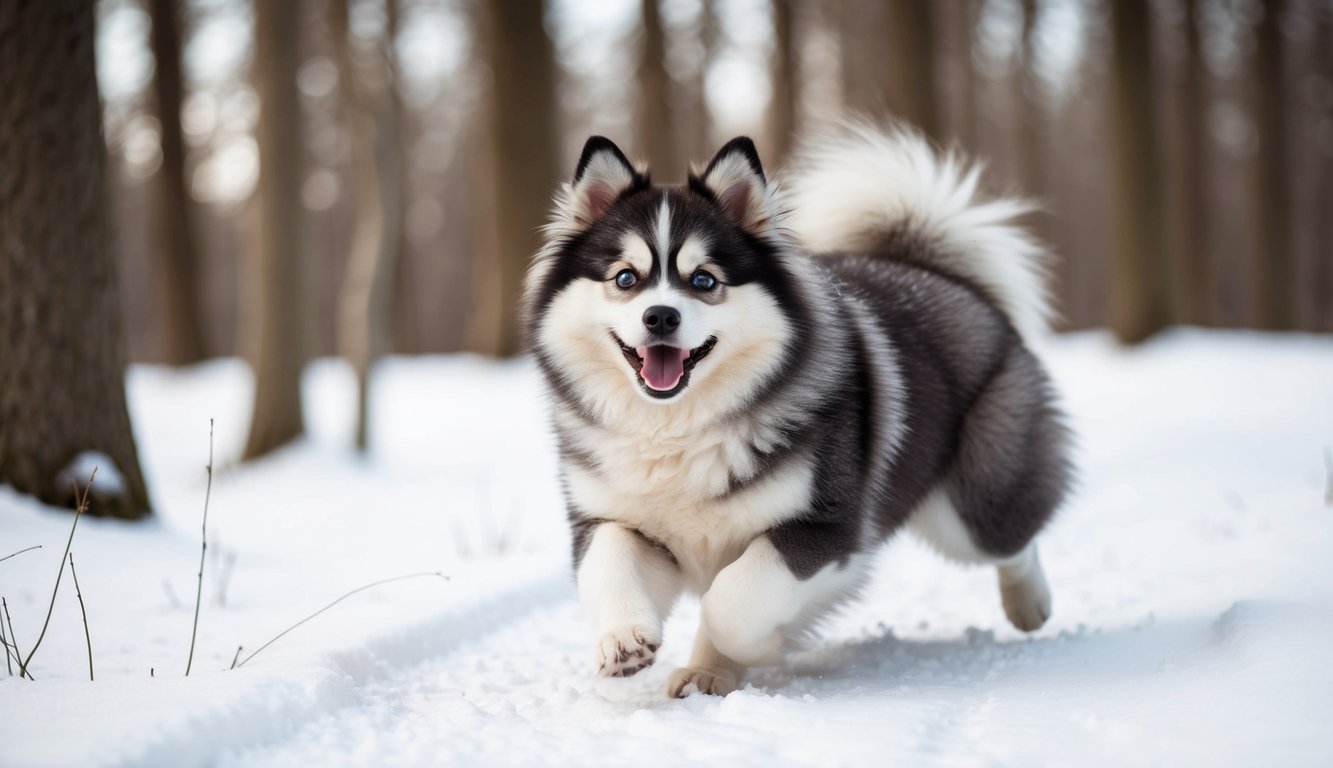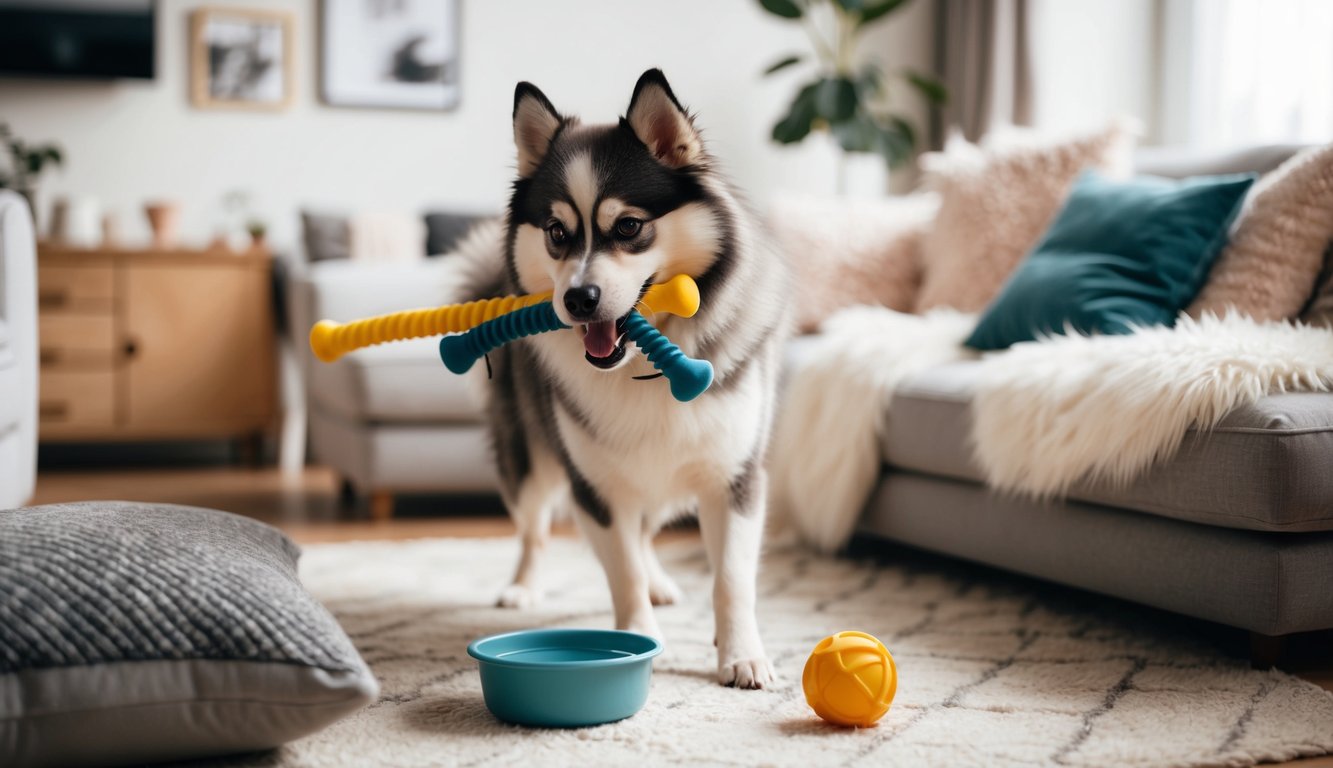The first documented mention of a Pomsky appeared in 2009 when someone posted about adopting a Pomeranian-Husky mix from a shelter. A veterinarian later proved this claim was false, as natural breeding between these breeds was extremely rare. The actual first Pomsky litter was born in 2012 in the United States. This milestone sparked major interest from dog enthusiasts and breeders across the country.
Let’s explore this mix in more detail. And, if you’re still on the market to buy a Pomsky, PuppySpot currently offers a $300 discount using the code PUPPY300, just click the banner below!
Pomsky Appearance Characteristics
The Pomsky combines distinct features from both parent breeds, creating a unique dog that resembles a miniature wolf or tiny Husky. The breed displays striking facial markings, thick double coats, and a size that falls between its parent breeds.
Size and Weight
- Pomsky dogs range from small to medium-sized, depending on which parent breed’s genes are more dominant. Adult Pomskies typically stand between 10-15 inches tall at the shoulder.
- Their weight varies significantly between individual dogs. Most adults weigh between 15-30 pounds when fully grown.
- First-generation Pomskies tend to be larger than subsequent generations due to the size difference between parent breeds.
Coat and Color Variations
These dogs inherit the thick double coat characteristic of both parent breeds. The outer coat is straight and water-resistant, while the undercoat is soft and dense.
Common coat colors include:
- Black and white
- Pure white
- Red and white
- Gray and white
- Brown and white
Many Pomskies display the classic Husky markings, including masks, eye patches, and distinct color patterns across their bodies.
Distinctive Facial Features
Pomsky facial features often mirror those of a Siberian Husky, just in a smaller size. They typically have pointed ears that stand erect and almond-shaped eyes.
Eye colors can be:
- Blue
- Brown
- Mixed (one of each color)
Their faces show a fox-like appearance with a medium-length muzzle and alert expression. Most have the signature Husky mask markings around their eyes and face.

Temperament and Personality Traits
The Pomsky combines traits from both parent breeds to create a smart, energetic, and affectionate companion. These dogs need clear boundaries and consistent training to manage their strong-willed nature.
Behavioral Tendencies
- Pomskies inherit vocal tendencies from both parent breeds, often expressing themselves through howling, whining, and high-pitched barking. They display high energy levels and require regular mental stimulation to prevent boredom.
- These dogs are known for their intelligence and quick learning abilities. Without proper training, they can become stubborn and develop unwanted behaviors.
- Their playful nature makes them entertaining pets, but they need structured exercise and training sessions to channel their energy positively.
Interaction with Family
- Pomskies work best in homes with adults and older children due to their independent personality. They form strong bonds with their family members but need proper socialization from an early age.
- These dogs show loyalty and affection toward their loved ones. They require constant attention and can become anxious when left alone for long periods.
- Teaching children the proper way to handle these dogs is essential. Despite their cute appearance, they are not stuffed toys and need respectful treatment.
Compatibility with Other Pets
- These designer dogs typically get along with other pets when introduced properly and socialized early. Their small size helps them adapt to living with larger dogs.
- Early socialization is crucial for developing good relationships with cats and other household pets. Their prey drive can surface occasionally, requiring supervision during initial interactions.
- Regular positive experiences with other animals help create a well-adjusted Pomsky that plays well with furry siblings.
Health and Lifespan Considerations
The Pomsky breed typically lives 12-15 years and requires specific health monitoring due to their unique genetic makeup. Regular vet checkups and proper care help these mixed-breed dogs maintain optimal health throughout their lives.
Common Health Issues
Pomskies can inherit health conditions from both parent breeds. Dental problems and obesity are common concerns that need attention.
Common health issues include:
- Eye problems like progressive retinal atrophy
- Hip dysplasia
- Skin allergies
- Collapsed trachea
- Heart problems
Small dog breeds often face dental challenges, so regular teeth cleaning is essential. Weight management needs careful attention since excess pounds can strain their joints.
Life Expectancy
Pomskies have a life expectancy of 13-15 years with proper care and attention. Their smaller size often contributes to their longer lifespan compared to larger dogs.
Factors affecting lifespan:
- Diet quality
- Exercise routine
- Genetic health
- Regular veterinary care
- Living environment
Indoor Pomskies often live longer due to reduced exposure to accidents and environmental hazards.
Preventative Care Tips
Early detection and prevention play key roles in maintaining a Pomsky’s health.
Essential preventative measures:
- Regular Vet Visits: Schedule checkups every 6 months
- Dental Care: Daily brushing and professional cleanings
- Weight Management: Regular exercise and portion control
- Grooming: Weekly brushing and monthly baths
- Vaccinations: Keep shots up to date
Monitor your Pomsky’s behavior and eating habits. Changes in appetite, energy levels, or behavior might signal health issues that need attention. Purchase pet insurance early to help manage potential health costs.

Pomsky Care Requirements
Caring for a Pomsky requires dedicated attention to diet, daily exercise, and regular grooming to maintain their health and happiness. These mixed-breed dogs need specific nutrition, structured physical activity, and frequent brushing of their thick double coat.
Dietary Needs
- Pomskies typically weigh between 20-30 pounds and need high-quality dog food formulated for small to medium breeds. Feed adult Pomskies twice daily with measured portions to prevent overeating.
- Protein should make up 25-30% of their diet to support their energetic nature. Fresh water must be available at all times.
- Watch for signs of food allergies, which can be common in mixed breeds. Avoid table scraps and human food, as Pomskies can gain weight easily.
Exercise Routines
These intelligent dogs need 45-60 minutes of exercise daily. Split activity into 2-3 sessions to prevent overexertion.
Recommended Activities:
- Daily walks
- Fetch games
- Agility training
- Interactive puzzle toys
Keep exercise varied to challenge both their Husky and Pomeranian traits. Mental stimulation through training games helps prevent boredom and destructive behavior.
Grooming and Cleanliness
Regular brushing is essential for Pomskies due to their thick double coat. Brush 3-4 times weekly to prevent matting and reduce shedding.
Basic Grooming Schedule:
- Daily coat check
- Weekly nail trimming
- Monthly baths
- Seasonal coat blowing care
Clean their ears weekly to prevent infections. Brush teeth 2-3 times weekly to maintain dental health. During shedding seasons, increase brushing frequency to daily sessions. Use a pin brush and undercoat rake to remove loose fur effectively.
Training and Socialization
Pomskies are intelligent dogs that combine the quick learning ability of Pomeranians with the independent nature of Huskies. Their unique personality traits require specific training approaches and early socialization to develop into well-behaved companions.
Puppy Training Basics
Start training as early as possible with a consistent routine. House training should begin immediately when bringing the puppy home. Use positive reinforcement with treats and praise. Pomskies respond well to reward-based training methods.
Essential Commands to Teach:
- Sit and stay
- Come when called
- Walking on leash
- Crate training
- Potty training
Short, frequent training sessions work better than long ones. Keep sessions to 5-10 minutes for puppies.
Socialization Importance
Early socialization helps prevent behavioral issues and creates a confident, well-adjusted adult dog.
Expose puppies to different:
- People and children
- Other dogs and pets
- Environments
- Sounds
- Surfaces
Make each new experience positive with treats and praise. Never force interactions if the puppy shows fear. Puppy classes provide structured socialization opportunities under professional guidance.
Obedience and Behavioral Training
Pomskies need clear boundaries and consistent rules. Their intelligent nature means they can learn quickly but may also test limits.
Key Training Areas:
- Leash manners
- Recall commands
- Impulse control
- Reducing excessive barking
- Preventing destructive behavior
Mental stimulation through puzzle toys and training games helps prevent boredom and unwanted behaviors. Professional training classes can help address specific behavioral challenges. Regular practice maintains good behavior long-term.



